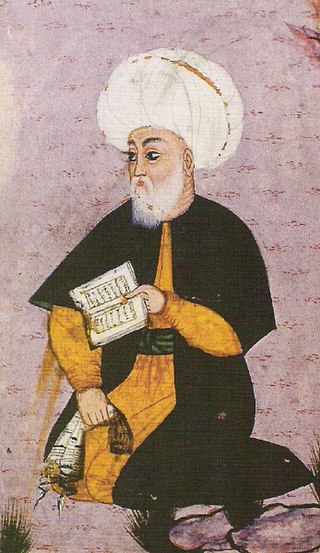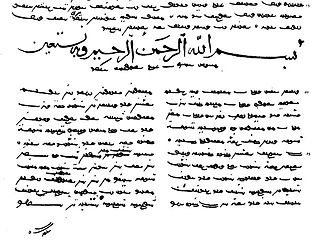Related Research Articles

Azerbaijani or Azeri, also referred to as Azeri Turkic or Azeri Turkish, is a Turkic language from the Oghuz sub-branch. It is spoken primarily by the Azerbaijani people, who live mainly in the Republic of Azerbaijan, where the North Azerbaijani variety is spoken, while Iranian Azerbaijanis in the Azerbaijan region of Iran, speak the South Azerbaijani variety. Azerbaijani has official status in the Republic of Azerbaijan and Dagestan, but it does not have official status in Iran, where the majority of Iranian Azerbaijani people live. Azerbaijani is also spoken to lesser varying degrees in Azerbaijani communities of Georgia and Turkey and by diaspora communities, primarily in Europe and North America.

Turkmen is a Turkic language of the Oghuz branch spoken by the Turkmens of Central Asia. It has an estimated 4.3 million native speakers in Turkmenistan, and a further 719,000 speakers in northeastern Iran and 1.5 million people in northwestern Afghanistan, where it has no official status. Turkmen is also spoken to lesser varying degrees in Turkmen communities of Uzbekistan and Tajikistan and by diaspora communities, primarily in Turkey and Russia.

The Masnavi, or Masnavi-ye-Ma'navi, also written Mathnawi, or Mathnavi, is an extensive poem written in Persian by Jalal al-Din Muhammad Rumi, also known as Rumi. It is a series of six books of poetry that together amount to around 25,000 verses or 50,000 lines. The Masnavi is one of the most influential works of Sufism, ascribed to be like a "Quran in Persian". Some Muslims regard the Masnavi as one of the most important works of Islamic literature, falling behind only the Quran. It has been viewed by many commentators as the greatest mystical poem in world literature. It is a spiritual text that teaches Sufis how to reach their goal of being truly in love with God.

Seyid Ali Imadaddin Nasimi, commonly known as simply Nasimi, was a 14th- and 15th-century Hurufi poet who composed poetry in his native Azerbaijani, as well as Persian and Arabic languages. He is regarded as one of the greatest Turkic poets of his time and one of the most prominent figures in Azerbaijani literature. Some sources also mention that he was born in Baghdad in 1339.
Turkish literature comprises oral compositions and written texts in the Turkish language. The Ottoman form of Turkish, which forms the basis of much of the written corpus, was highly influenced by Persian and Arabic literature, and used the Ottoman Turkish alphabet.

Azerbaijani literature is written in Azerbaijani, a Turkic language, which is the official state language of the Republic of Azerbaijan, where the North Azerbaijani variety is spoken. It is also natively spoken in Iran, where the South Azerbaijani variety is used, and is particularly spoken in the northwestern historic region of Azerbaijan. Azerbaijani is also spoken natively in Russia, Georgia and Turkey. While the majority of Azerbaijani people live in Iran, modern Azerbaijani literature is overwhelmingly produced in the Republic of Azerbaijan, where the language has official status. Three scripts are used for writing the language: Azerbaijani Latin script in the Republic of Azerbaijan, Arabic script in Iran and Cyrillic script formerly used in Soviet Azerbaijan.

Muhammad bin Suleyman, better known by his pen name Fuzuli, was a 16th-century poet who composed works in his native Azerbaijani, as well as Persian and Arabic. He is regarded as one of the greatest poets of Turkic literature and a prominent figure in both Azerbaijani and Ottoman literature. Fuzuli's work was widely known and admired throughout the Turkic cultural landscape from the 16th to the 19th centuries, with his fame reaching as far as Central Asia and India.

The Kutadgu Bilig or Qutadğu Bilig is an 11th-century work written by Yūsuf Balasaguni for the prince of Kashgar. The text reflects the author's and his society's beliefs, feelings and practices with regard to quite a few topics and depicts interesting facets of various aspects of life in the Kara-Khanid Khanate.
Mathnawi or masnavi is a kind of poem written in rhyming couplets, or more specifically "a poem based on independent, internally rhyming lines". Most mathnawī poems follow a meter of eleven, or occasionally ten, syllables, but had no limit in their length. Typical mathnawi poems consist of an indefinite number of couplets, with the rhyme scheme aa/bb/cc.

The Epic of Koroghlu is a heroic legend prominent in the oral traditions of the Turkic peoples, mainly the Oghuz Turks. The legend typically describes a hero who seeks to avenge a wrong. It was often put to music and played at sporting events as an inspiration to the competing athletes. Koroghlu is the main hero of an epic with the same name in Azerbaijani, Turkmen and Turkish as well as some other Turkic languages. The epic tells about the life and heroic deeds of Koroghlu as a hero of the people who struggled against unjust rulers. The epic combines the occasional romance with Robin Hood-like chivalry.
Yusuf and Zulaikha is a title given to many tellings in the Muslim world of the story of the relationship between the prophet Yusuf and Potiphar's wife. Developed primarily from the account in Sura 12 of the Qur'an, a distinct story of Yusuf and Zulaikha seems to have developed in Persia around the tenth century CE. According to Agnès Kefeli, "in the biblical and Qur’anic interpretations of Joseph's story, Potiphar's wife bears all the blame for sin and disappears quickly from the narrative". But "in Turkic and Persian literatures, Joseph and Zulaykha do, ultimately, become sexually united, in parallel to their noncorporeal mystical union". The story of Yusuf and Zulaikha is subsequently found in many languages, such as Arabic, Persian, Bengali, Turkish, Punjabi and Urdu. Its most famous version was written in the Persian language by Jami (1414–1492), in his Haft Awrang.
A bayt is a metrical unit of Arabic, Azerbaijani, Ottoman, Persian, Punjabi, Sindhi and Urdu poetry.
Azerbaijani folklore is the folk tradition of Azerbaijani people.

Layla and Majnun is an old story of Arab origin, about the 7th-century Arabic poet Qays ibn al-Mulawwah and his lover Layla bint Mahdi.

Sharif Aghayar is an Azerbaijani writer.

Turkoman, also known as Turcoman, was a term for the people of Oghuz Turkic origin, widely used during the Middle Ages. Oghuz Turks were a western Turkic people that, in the 8th century A.D, formed a tribal confederation in an area between the Aral and Caspian seas in Central Asia, and spoke the Oghuz branch of the Turkic language family.
Habibi was a late 15th and early 16th century poet. He is regarded as the most important Azerbaijani poet of his generation.
Yeni Kafkasya The journal first published by Azerbaijani emigrants living in the Republic of Turkey.
Mehri and Vafa is one of the first works written in Azerbaijani language, written by Ummi Isa. The language of the poem is distinguished by its simplicity and comprehensibility, as it is written in a folkloric, colloquial language. Service to the poem "Book of Dede Korkut" and "Dastani-Ahmed Harami" "Mehri va Vafa" is written in a simpler language and is a development form for the modern reader to understand. The language of the poem is dominated by words of Turkish origin. Its grammatical structures differ only slightly from modern Azerbaijani.
References
Notes
Citations
- ↑ Eren H. Yûsuf-i Meddâh, Yûsufî, Şâzî // Türk Edebiyatı İsimler Sözlüğü. — Ahmet Yesevi University, 2014.
- ↑ Smith 1976, p. Preface.
- ↑ Aksoy 2013; Eren 2014; Smith 1976, p. 4.
- 1 2 Smith 1976, p. 5.
- 1 2 3 Aksoy 2013; Eren 2014.
- 1 2 Mustafayev 2013, p. 337.
- 1 2 Babayev 2008, p. 115.
- ↑ Aksoy 2013; Eren 2014; Kayaokay 2022.
- ↑ Smith 1976, p. 4.
- 1 2 3 Aksoy 2013.
- ↑ Ağayeva 2021, p. 478.
- 1 2 Tolu 2021, p. 601.
- 1 2 Smith 1976, p. 7.
- ↑ Smith 1976, p. 20.
- ↑ Kayaokay 2022, p. 29.
- 1 2 Kayaokay 2022, pp. 27–28.
- ↑ Aksoy 2013; Eren 2014; Ağayeva 2021, pp. 476–477.
- ↑ Ağayeva 2021, p. 481.
- ↑ Smith 1976, p. 6.
- ↑ Aksoy 2013; Eren 2014; Ağayeva 2021, pp. 476–477; Smith 1976.
- ↑ Mustafayev 2013, p. 335.
Sources
- Aksoy, Hasan (2013). "Yûsuf Meddah". TDV Encyclopedia of Islam, Vol. 44 (Yusuf – Zwemer) (in Turkish). Istanbul: Turkiye Diyanet Foundation, Centre for Islamic Studies. ISBN 978-975-389-785-3.
- Ağayeva, Sevinc (August 2021). "Traces of Folk Literature in the "Maqtal" of Yusuf Maddah in the 14th Century" (PDF). Söylem Filoloji Dergisi. 6 (2): 476–481. doi:10.29110/soylemdergi.935736. ISSN 2548-0502. S2CID 238833119.
- Babayev, Yaqub (2008). Kərimli, T.H. (ed.). Ana Dilli Azərbaycan Ədəbiyyatının Təşəkkülü və Epik Şeirin İnkişafı (XIII-XIV Əsrlər) [Organization of Native Azerbaijani Literature and Development of Epic Poetry (13th-14th centuries)](PDF) (in Azerbaijani). Azerbaijan State Pedagogical University.
- Eren, Hulusi (2014). "Yûsuf-i Meddâh, Yûsufî, Şâzî". Türk Edebiyatı İsimler Sözlüğü (in Turkish). Ahmet Yesevi University.
- Kayaokay, İlyas (2022). 14. Asrın Yeni Keşfedilen İki Eseri: Hikâyet-i Yemâme / Sehâvet-i Imâm 'Ali [Two Newly Discovered Works of the 14th Century: Hikâyet-i Yemâme / Sehâvet-i Imâm 'Ali] (in Turkish). DBY Yayınları. ISBN 978-625-7471-65-7.
- Meddāḥ, Yūsuf-i (1976). Smith, Grace Martin (ed.). Varqa Ve Gülşāh: A Fourteenth Century Anatolian Turkish Mes̲nevī. E. J. Brill. ISBN 978-90-04-04742-6.
- Mustafayev, Shahin (2013). "Ethnolinguistic Processes in the Turkic Milieu of Anatolia and Azerbaijan (14th–15th Centuries)". In Lascu, Stoica; Fetisleam, Melek (eds.). Contemporary Research in Turkology and Eurasian Studies: A Festschrift in Honor of Professor Tasin Gemil on the Occasion of His 70th Birthday. Cluj-Napoca: Cluj University Press. pp. 333–346. ISBN 978-973-595-622-6 . Retrieved 15 August 2023.
- Tolu, Orhan Aytuğ (31 December 2021). "Yûsuf-i Meddâh'ın Varka ve Gülşah Mesnevisinin Roman Tekniği Bakımından İncelenmesi". Hars Akademi Uluslararası Hakemli Kültür Sanat Mimarlık Dergisi (in Turkish). 4 (8): 571–603. ISSN 2636-8730.